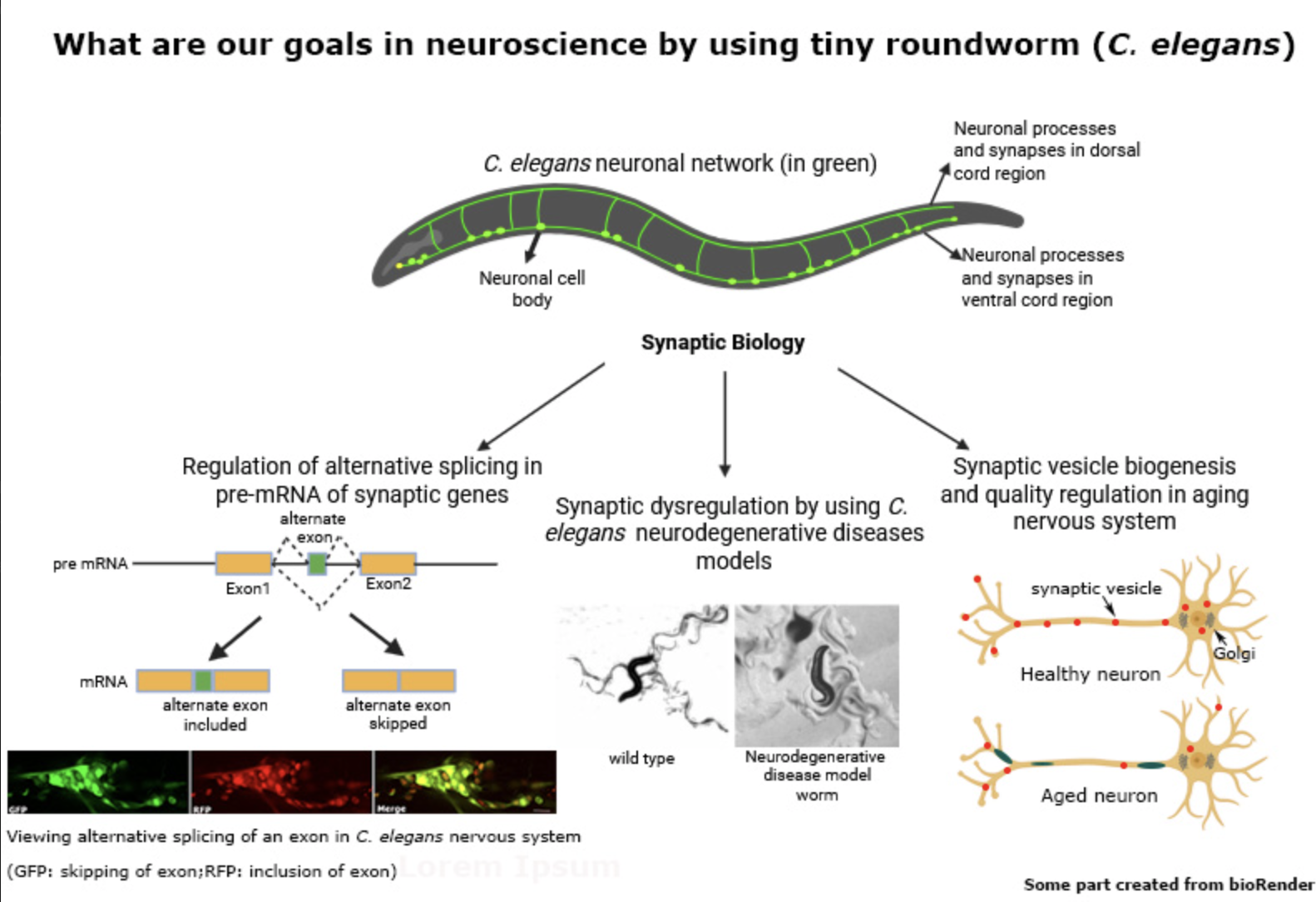Assistant Professor of Biology
Spencer Hall 161 / ext. 1915
bcchoudh@sewanee.edu
Research Interests
The broad goal of the lab is to understand how neurons communicate with one another
through synapses. Neuronal synapses are the fundamental units of communication in the
nervous system. We are particularly interested in how synapses are formed during
development and what molecular mechanisms ensure their long-term maintenance. My expertise in neuronal
transcriptomics and cell biology allows me to investigate synaptic biology at two levels:
a) By analyzing the transcriptomic and proteomic diversity of synaptic genes, especially those
arising from alternative splicing across different neuronal populations, and
b) By studying how specific gene variants influence synaptic function in distinct classes of
neurons.
This foundational knowledge will enhance our understanding of how synaptic biology is altered in various neurological disorders, from autism spectrum disorders (ASDs) to age-related neurodegenerative diseases. Synapses are classified under two major categories:
a) Chemical synapses, where neurons communicate via chemical neurotransmitters released by
synaptic vesicles, and
b) Electrical synapses, where electrical signals are transmitted via gap junctions.
Synaptic vesicles are nanoscale organelles enriched with membrane-associated proteins that
enable them to undergo tightly regulated cycles of exocytosis and endocytosis to release
neurotransmitters. How these proteins are specifically sorted into synaptic vesicles remains a
major question in the field. My lab is actively investigating the molecular machinery involved in
this sorting process, using a combination of genetics and cell biological approaches.

Publications
Choudhary B, Jameson N Rebekah, Norris AD. Regulated microexon alternative splicing in single neurons tunes synaptic function. EMBORep (2025)
Choudhary B, Norris AD. Conserved role for Spliceosomal component PRPF-40A in microexon splicing. accepted in RNA, 2024 (Reviewed for Editor’s First Choice)
Choudhary B, Marx O, Norris AD. Spliceosomal component PRP-40 is a central regulator of microexon splicing. Cell Reports, 2021.
Pir GJ, Choudhary B*, Kaniyappan S*, Chandupatla RR, Mandelkow E, Mandelkow EM, Wang Y. Suppressing Tau Aggregation and Toxicity by and Anti-Aggregant Tau Fragment. Mol. Neurobiology. 2019.
Choudhary B, Pir GJ, Mandelkow E, Mandelkow EM. The glutamatergic nervous system degenerates in Caenorhabditis elegans A152T tauopathy model via excitotoxicity and aging-related disorders. Neurobiol. Dis. 2018 June.
Choudhary B*, Kamak M*, Ratnakaran N, Kumar J, Awasthi A, Li C, Nguyen K, Matsumoto K, Hisamoto N, Koushika SP. UNC-16/JIP3 regulates early events in synaptic vesicle trafficking via LRK-1/LRRK2 and AP complexes. PLoS Genet. 2017 Nov
Pir GJ, Choudhary B, Mandelkow E. Caenorhabditis elegans models of tauopathy. FASEB J. 2017 Dec; Review
Pir GJ*, Choudhary B*, Mandelkow E, Mandelkow EM. Tau mutant A152T, a risk factor for FTD/PSP, induces neuronal dysfunction and reduced lifespan independently of aggregation in a C. elegans tauopathy model. Mol. Neurodegener. 2016 Apr
Arimoto M, Koushika SP, Choudhary BC, Li C, Matsumoto K, Hisamoto N. The Caenorhabditis elegans JIP3 protein UNC-16 functions as an adaptor to link kinesin-1 with cytoplasmic dynein. J Neurosci. 2011Feb.
Kumar J*, Choudhary BC*, Metpally R, Zheng Q, Nonet ML, Ramanathan S, Klopfenstein DR, Koushika SP. The Caenorhabditis elegans Kinesin-3 motor UNC-104/KIF1A is degraded upon loss of specific binding to cargo. PLoS Genet. 2010 Nov


